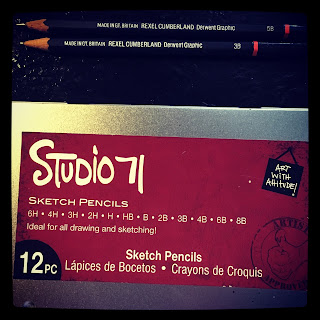Today, I will go over some basic drawing tools that you will need to get started. If you've ever taken any drawing class, you probably already have many or all of these things on hand. I am going to do pencil (or graphite) drawing first.
Pencil drawings are my choice for underdrawings or preparatory drawings. Pencil sketches are easy to do while out and about because you can always easily carry a small sketch pad, pencils and eraser and pencil sharpener with you. Pencils are pretty clean and self contained(unlike Charcoal which is fun to work with but very messy). Even #2 pencils on printer paper can work. It's just very accessible.
Pencil drawings are my choice for underdrawings or preparatory drawings. Pencil sketches are easy to do while out and about because you can always easily carry a small sketch pad, pencils and eraser and pencil sharpener with you. Pencils are pretty clean and self contained(unlike Charcoal which is fun to work with but very messy). Even #2 pencils on printer paper can work. It's just very accessible.
So, for our purposes, I recommend some decent drawing pencils. I love buying sets of drawing pencils(as you can see by the three examples shown here). They come in different combinations. Drafting sets usually use harder leads (H-9H), Sketching and Drawing sets usually have a couple harder(H-2H), HB, and softer leads(B-9B).
Softer leads(B) giver you darker, blacker lines; Harder leads(H) give you finer, lighter gray lines; An HB pencil is equivalent to a #2 school pencil. The higher the number, the harder or softer the pencil lead. Softer leads break more easily so it is essential to keep them safely stored(which is why I am so addicted to drawing sets, they usually come in fabulous tins). Unless I have to do a full rendering(finished drawing with shading), I usually only need up to a 2H pencil on the harder side. The 3H up to 9H are excellent for fine shading but I rarely use them for anything else. I love having the full range of soft leads(B-9B) as you can get really dark blacks and build the darks as you go. I also recommend the Ebony pencil. It is a very nice pencil with a thicker lead than average drawing pencils. It gives nice dark blacks and you can cover a lot of area while shading if you hold it at an angle. If you can only afford one pencil for sketching, I recommend the Ebony pencil. By far it has been the most versatile for me.
(Note: I have some Ebony pencils but I don't know where they are. A trip to the art store is in order, me thinks!)
In addition to pencils, You are going to need erasers. Yes, I intended to make that plural. There are three or four type of erasers I find vital when drawing.
My personal favorite is the kneaded eraser. These always seem to disappear in my house since they are fun to play with. A kneaded eraser can literally be kneaded, you pull it like taffy, as you pull it, and turn it back on itself, you clean it. Eventually, it will get to be dark gray and you'll know you need a new one but they really last a very long time and you may just find yourself buying another just because you love the smell of a new kneaded eraser(weird but true). The nice thing about kneaded erasers is they work well with pencils and charcoal, can be manipulated into points(or any other shape)and leave no erasures(the spent rubber other erasers leave behind). They are essential for working with charcoal and rarely tear your paper.
The next kind of eraser I recommend is a gum eraser. These are a brownish color and will crumble when you use them. Because of this, they rarely tear the paper. They are a bit messy but they do a great job safely erasing mistakes.
The standard pink pearl eraser is a rubber eraser. Similar to the gum eraser but a smidge neater, also a bit more effective removing graphite but if used too aggressively, you can tear your paper. That said if you can only afford one eraser at this time, I recommend this one or the plastic eraser.
The plastic eraser is made from vinyl, it is the toughest and most effective eraser here(it can even erase ink!) but there is a higher likelihood of tearing paper if used too aggressively. That said, it lasts a very long time. They come in different shapes and sizes but usually they are white(like my tri-tip in the first photo).
Finally, you will need pencil sharpeners. Art students usually have a utility knife in their supply box that they will use to put a point on their pencils when away from their electric sharpeners. While I still like using a utility knife(it seems to waste less pencil), I highly recommend a small hand held sharpener to carry with your pencils and a good electric pencil sharpener at home. It's much more efficient. But never forget, in a pinch, you can use a pocket or utility knife.
So here is a list of what to look for to start drawing(minus paper because that will need its own post):
Pencils
-Ebony or #2 if you can only afford one.
Eraser
-pink pearl or white plastic to start
Hand held pencil sharpener
Next post I will discuss paper. You'd think it was a no brainer but a lot goes into choosing a good drawing paper so I will go into great length what to look for and what you may want to avoid.
Until then, Thanks for reading! 💖Kelly



